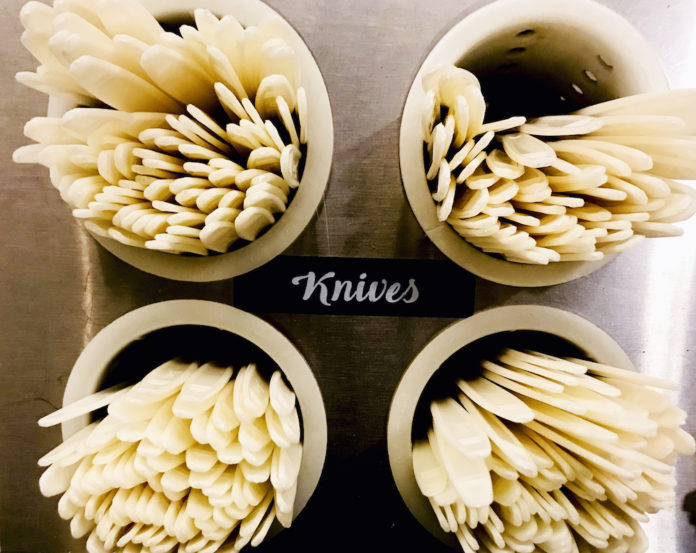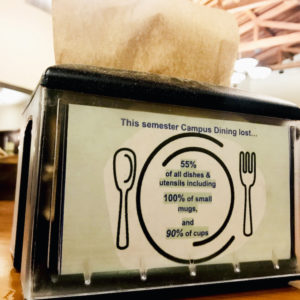
Occidental students are taking more than their backpacks and laptops with them when they leave the Marketplace after each meal. In the Fall 2019 semester, Campus Dining lost 55 percent of its dinnerware inventory, according to Judy Runyon, director of operations for Hospitality Services. This loss, which included 100 percent of small mugs and 96 percent of tumblers, cost Campus Dining an estimated $4,500.
While some inventory loss is expected every semester, the Marketplace lost more in Fall 2019 than in any of the past four semesters, according to Runyon. She offered several possible explanations for this trend.
“A very little amount breaks, or people accidentally throw away silverware with trash, or they get lost,” Runyon said. “But most of our lost stuff just goes out of the Marketplace.”
Runyon said she and other Campus Dining staff frequently see Marketplace plates, bowls and cutlery on the quad, on benches and at the library. The most common spot for these items to end up, however, is student housing.
“At the end of the semester, someone in Facilities would go to the dorms and comb the kitchens after students left,” Runyon said. “She would bring back crates of stuff for us.”
Kaye Jenkins (junior), the lead intern for sustainability research with Campus Dining, said this issue extends to off-campus housing as well.
“A lot of the students who move off campus don’t necessarily want to go to Ikea and buy a full set of silverware. It’s so much easier to take it from the MP,” Jenkins said. “If you just want to make oatmeal in the morning, you’re not gonna go buy one spoon.”
The dine-in tableware is more costly than people realize, according to Runyon. One plate costs $6.28 and pasta bowls cost almost $8 each.
“I wish people would realize the impact of taking these expensive items,” Runyon said. “Everyone’s mentality is ‘What’s one plate?’ But if 80 people think that, that’s 80 fewer plates that we have for service.”
As part of her job, Jenkins compiled a spreadsheet of Marketplace inventory loss. She found some items disappear more frequently than others. While fewer pasta bowls and large plates were taken, cups and utensils were lost at much higher rates, from 90 to 100 percent.
“[People usually take] forks and spoons that are super easy to clean and tuck in your backpack. I don’t think it’s an accident,” Jenkins said.

Eco-clamshells, the Marketplace’s sustainable multi-use to-go container, are lost at extremely high rates as well, according to Jenkins. This is partially because students usually take a to-go container for convenience and do not want to bring it back.
“We lose eco-clamshells like crazy,” Jenkins said. “When we go through dorms later to look for these, we will find 30 or so.”
Another factor in inventory loss is time of the day, according to Eileen Castellon, Marketplace supervisor.
“During lunch we have two separate rushes, which allows us to wash and put the silverware back in service,” Castellon said. “Whereas at dinner everyone tends to come at the same times, which doesn’t give the break in between for turnover.”
Whatever the reasons are for students taking or losing dinnerware, it has an impact on Campus Dining’s services, according to Castellon.
“It takes away from our budget that can be used to make other improvements throughout the Marketplace,” Castellon said.
Part of Jenkins’ job as a sustainability intern is to research new products Campus Dining can shift to that are more local, organic or sourced from humane supply lines. She also works to improve the sustainability of Campus Dining’s food and operations through fewer single-use plastic and more compostable containers. According to Jenkins, students taking dinnerware detracts from these sustainability efforts.
“If we have to keep buying plates, it defeats the purpose of dine-in flatware and [takes] money away from more sustainable products that are a little more expensive,” Jenkins said. “It’s the same account we use for to-go containers, so this makes it more expensive to accommodate compostable to-go containers.”
In addition to hampering sustainability efforts, this massive inventory loss can have other direct impacts on students, according to Runyon.
“Our budget does not increase for small equipment [such as dinnerware], so we can only purchase so much, unfortunately,” Runyon said. “If we can’t get enough plates to sustain service, we need to get compostables. And that affects our food costs because disposable stuff comes out of the food account. We try to keep food costs at a certain rate so we don’t have to raise prices.”
According to Runyon, compostables are sustainable, but they represent a large cost to Campus Dining since they are single-use. She and Castellon said the most sustainable option is for students to do their part to keep all the dinnerware in service.
“We [Campus Dining staff] have tried emails, table advertisements and have also had our staff going around to dorms to collect any silverware and plates,” Castellon said. “Students can help by not removing the silverware from the Marketplace. If it is removed, it’s no longer sustainable.”
![]()



































[…] return the items has left Peirce with a diminished supply of cups, bowls, cutlery and plates. While missing dishware is a nuisance that plagues many dining halls, Peirce Dining Hall has experienced drastic and rapid […]